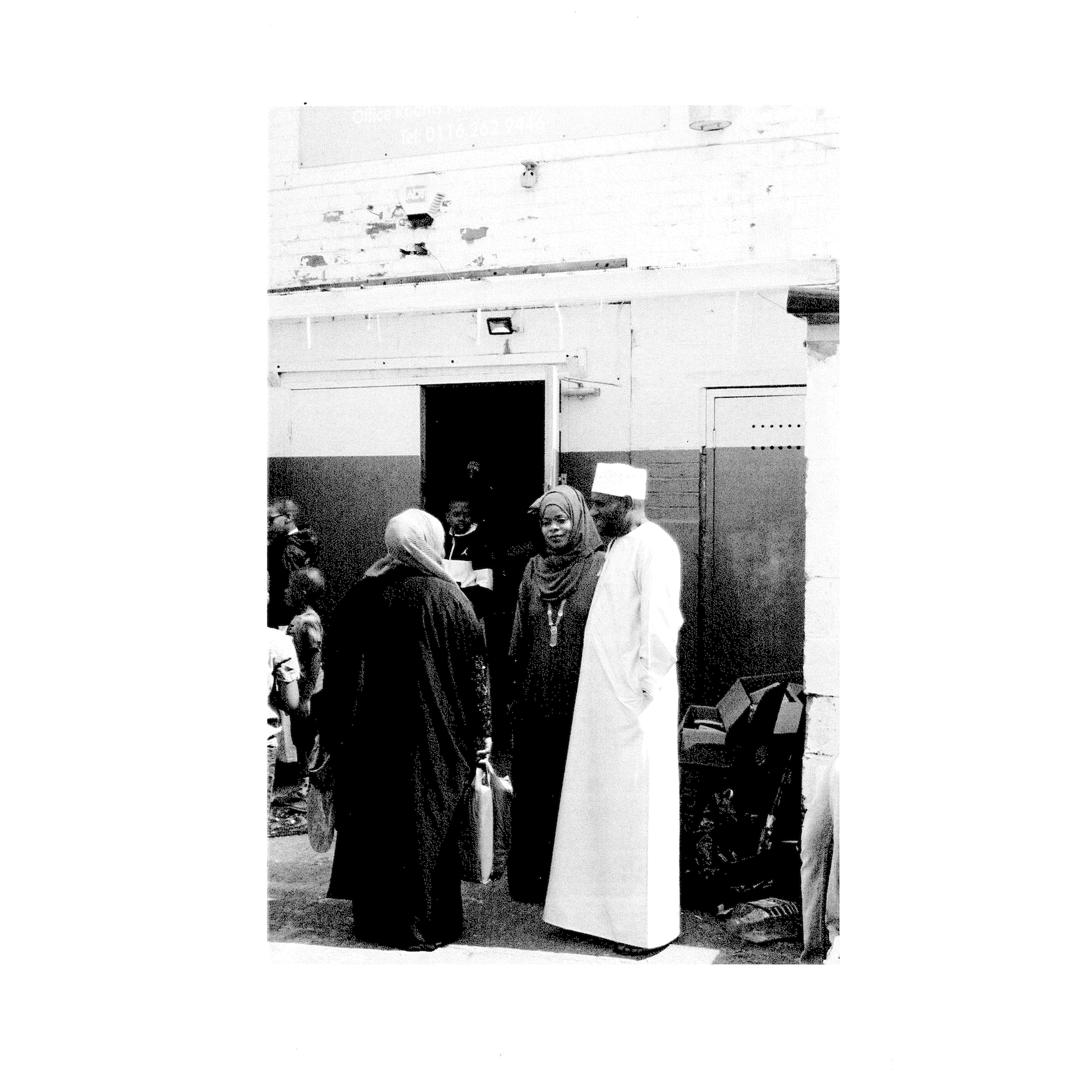What is a relative? with reference to anthropological theories of kinship.
Camera : Olympus OM-10
Location: Leicester
The essay will delve into the development of kinship in anthropology by, exploring how traditional notions of kinship were tied to marriage and blood and how anthropologist understood kinship systems in its early form as arrangements in terms of descent and alliance. The second half of the essay will zoom into contemporary kinship studies. Where cultural characteristics of the relative, as a social function are brought to the surface in contemporary kinship studies. All this is necessary as it helps think through this contemporary definition of kinship and how it may apply to the continuum of what a family is today and what it may be for the near future.
The use of relevant text will range from the works of Radcliffe brown (1987) ‘African systems of kinship and marriage’ and Levi-Strauss ‘The Elementary Structures of Kinship’ (1949) to give us an description of early theories of kinship and why these early theories cannot be used to explain the contemporary definition and functions of kinship, as the study of kinship has evolved since then. Afterwards, we’ll delve into the works of Daniel Schneider (1968) ‘American Kinship: a cultural account’ to see the contemporary definition of kinship followed by Signe Howell’s study (2003) through the example of ‘kinning’ as this will demonstrate the changes in the definition and functions of kinship.
An early perspective of kinship
Kinship has been central to anthropology as a way of explaining how ‘stateless’ societies operated without a recognisable system of politics. Kinship was seen by early anthropologists such as Malinowski and Radcliffe-Brown as providing coercive power and as the primary source for rules and regulations for the order and continuity of social life of the ‘native’ society. In such ‘small-scale’ societies, the primary social organisation was seen to be kinship based. Radcliffe-Brown emphasises, ‘A system of kinship and marriage can be looked at as an arrangement which enables a person to live together and cooperate with one another in an orderly social life.’ (Radcliffe Brown 1987: 3). The idea of kinship that was being defined at this time was to figure out how this relationship of transmission, were actually organizing whole societies.
Theories arose during this time around the idea of kinship. The first set of theories was the descent theory, this was about how things are transmitted and how we can classify societies in relation to what is transmitted and how it’s transmitted. It formed the dominant approach to kinship in anthropology until the 1960’s. In the 1960’s, the alliance theory emerged challenging the descent models of kinship, it marked a significant shift from the claims that kinship is primarily concerned with the social and cultural elaboration of biological facts, to the view that kinship is principally about the establishing of alliances between groups through marriage. Here it’s indicated how there's a transformation in approaches within the study of kinship, as it moves away from blood/marriage, demonstrating the continual flux the study of kinship is in.
Levi-Strauss (1949) made his own commentary through his book ‘The Elementary Structure of Kinship’. His thought were that this elementary structure of kinship allow for the emergence of classes of relatives followed with the determination of relationships, and the abstract rules of exchange allow us to think of kinship as a basis of social structure. These determination of relationships were zoomed into further down the line in anthropology.
Anthropologists applied these theories of kinship here in England. An example would be ‘Kinship at the Core’ by Marilyn Strathern (1981), one of the first studies which wanted to illustrate these theories in the village of Elmdon. One thing they found out is that the idiom of kinship is linked to ideas of belonging to the village. This was a way of enforcing divisions (the determination of relationships) between those who have been in the village since birth to others that arrived later. This made anthropologists think about what social hierarchies were derived from thinking about kinship in this way. As it may lead to naturalizing a series of social relationships and inequalities through the idiom of kinship.
A critique of kinship in its early stage
Many started criticizing the theories previously mentioned for being universal. For trying to make assumptions and take them as the truth. This led to a deep critic in the 60’s of kinship studies. One of the leading components to this critique was the american anthropologist David Scheider. Schneiders (1968) work ‘American Kinship: a cultural account’ is the basis of contemporary view of kinship as he focused on the characteristics of the relative and what made a relative. His work illustrates how there are 2 aspects to his argument about relatives, those aspect being biological and the cultural constructions of what it meant in daily life. These cultural constructions were linked to symbols and the law. Carsten puts it well by stating ‘a crucial aspect of Scheider’s influence is the role played in his writing by ‘nature’ or ‘biology’ and its separation from law, which is itself encompassed by ‘culture.’’ (Carsten, J 2000: 6). Schneider emphasises how these symbols wouldn’t be so powerful if they weren’t ratified by law. This is the first time that we see the law come to play with defining what kinship is, Scheider summarises his argument by suggesting that the thing that we take for the natural basis for kinship is in fact a social construction.
This changed the focus of kinship studies, so instead of trying to find about a particular unit or family through blood, we are not trying to understand what are the social relationship that are linking people together, and what are the obligations and transmissions.
‘Kinning’
This shift in focus has allowed us to see the definition of kinship in a new light, Signe Howell demonstrates this by looking at the social relationships that tie us together with others (relatives).
The symbolic aspect of kinship are illustrated in Howell’s (2003) study ‘Kinning: The Creation of Life Trajectories in Transnational Adoptive Families’, in Norway. Transnational adoptions had been on an increase due to the fact that in Norway, less and less babies born from the nation had been offered for adoption. Flagging up issues surrounding national identity and blood kinship ties (its authenticity). In this respect, the term ‘kinning’ as described by Howells is thereby, ‘the process by which a foetus or new born child (or a previously unconnected person) is brought into a significant and permanent relationship with a group of people that is expressed in a kin idiom.’ (Howell 2003: 465). There's a symbolic element regarding the kinning of the child, being given something such as a family name can be the transubstantiation for the child to be a part of the kinship circle, Howell explains it in terms of…
‘To share the same blood means to share certain physical resemblances as well as insubstantial qualities, such as personality, interests, and abilities inherent in, for example, 'being an Andersen'. This may be said to provide the social dimension of kinship, which creates continuity over time, and gives people a sense of belonging to 'a life', to something bigger than the individual’
(Howell 2003: 466)
But processes of kinning ultimately emphasises a social aspect of kin in contrast to a biogenetic perspective on this matter, highlighting a wider view of what kinship in contemporary anthropology is.
Transubstantiation begins with a child's arrival in Norway, when their social status is reconstituted. This reconstitution segment can be facilitated by events such as taking a picture of the child with his new family. This is the building of a new social relationship and following series of events will maintain it. Howell paints the picture to us as...
‘in places that epitomize the ideals of Norwegian family life and kin relatedness: In these photographs little or no concession is made to the child's country of origin. The clothing is relentlessly Norwegian, ranging from national costume on important occasions to standard children's outdoor clothing...’
(Howell 2003: 472)
This elaborates the idea of how biology is no longer the foundational thought of kinship. In short, through insight from Howell’s case study, the shift in perspective on kinship in anthropology becomes clearer. Blood relations is not seen as the leading factor but social relations that are built and maintained are.
Concluding thoughts
Kinship was for a long time about blood relations, as blood is a symbol that carries with it alot of meaning. Moreover, blood has been fixated on as an explanation for kinship during early stages of kinship studies as a way of governing ‘stateless’ societies. Kinship has gone through a paradigm shift as it has moved away from blood relations to now understanding how social relations and arrangements link others together. Links from social arrangements and relations are kept in maintenance, this is what kinship is in its contemporary definition for now. Kinship can be seen as a continuum, remaining in a state of continual flux as the focus within the study shifts.
Bibliography:
- Howell, S. (2003). Kinning: The Creation of Life Trajectories in Transnational Adoptive Families. The Journal of the Royal Anthropological Institute, 9(3), 465-484. Retrieved from http://www.jstor.org/stable/3134598
- Cyril Daryll Forde, A. R. Radcliffe-Brown, International African Institute (1987) African systems of kinship and marriage, London, New York, New York, NY, USA: Distributed by Routledge & Kegan Paul, KPI in association with the International African Institute.
- Marilyn Strathern (1981) Kinship at the core: an anthropology of Elmdon, a village in north-west Essex in the nineteen sixties, Cambridge: Cambridge University Press.
- Janet Carsten (2000) Cultures of relatedness: new approaches to the study of kinship, Cambridge [England], New York: Cambridge University Press.
- Schneider, D. M. (1968). American kinship: a cultural account. Englewood Cliffs, N.J.: Prentice-Hall.
- Scheffler, H. (1970). The Elementary Structures of Kinship by Claude Lévi-Strauss: A Review Article. American Anthropologist,72(2), new series, 251-268. Retrieved from http://www.jstor.org/stable/671570

